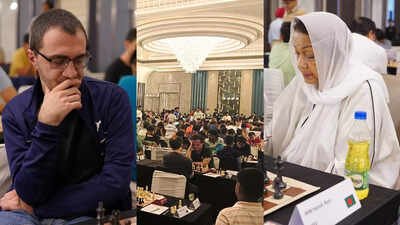
NEW DELHI: After Gukesh Dommaraju won the Candidates last year in Toronto, Garry Kasparov — former world champion and one of the greatest players in history — famously said, “The ‘children’ of Vishy Anand are on the loose.” He later hailed Gukesh’s achievement as “shifting tectonic plates in the chess world.”Kasparov was proved right when, six months later, at the age of 18, Gukesh became the youngest world chess champion in history, surpassing Kasparov himself, who had won the crown in 1985 at the age of 22.Kasparov’s prophetic words appear to be coming true.A glimpse of that shift was seen last week at the Tivoli Garden Resort in Delhi’s Chhatarpur, where a cavernous hall — large enough to host an indoor football match — was transformed into a battlefield of brains for a week.

Playing hall of Section ‘A’ at Delhi GM Open Tournament. (Special Arrangement)
The Delhi International Open Grandmasters Chess Tournament, held from June 7 to 14 under the aegis of the Delhi Chess Association (DCA), drew a fascinating mix: Grandmasters (GMs), International Masters (IMs), Women International Masters (WIMs), Candidate Masters (CMs), and Woman FIDE Masters (WFMs) from across the globe.And in that sea of talent, one thing was unmistakable: India’s young stars were setting the board on fire, leaving even seasoned players in awe.‘It’s so much harder now’Take 36-year-old Georgian GM Tornike Sanikidze. After each game, you’d find him stepping out for a smoke, often joined by compatriot and fellow GM Levan Pantsulaia. Their conversations, between drags, almost always circled back to one theme: the fierce challenge posed by India’s young guns.“This tournament is very beautiful and very hard,” Sanikidze, who was seeded 18th but finished 53rd, admitted to TimesofIndia.com after his final round. “There are so many grandmasters, and so many kids. That makes it a very strong tournament. It was very hard for me.”
Sanikidze knows what he’s talking about: “I was here in 2013. Even then, I could see the new generation coming. Back then, I was rated 2518, and I left at 2513; that’s how hard it was to play Indians. And now? Look at the top 10. There are four Indians. The world champion is Indian. That says everything.”A chess revolutionSlovak GM Mikuláš Maník, 50, is no stranger to Indian tournaments; this was his 44th. But even he admits he’s been taken aback by the meteoric rise of India’s chess scene.“Every year, the tournaments here get stronger,” Maník observed, often seen outside the playing hall analysing games on a sideboard after a round of play, especially when his opponent was a prodigy.“India has done remarkable work with its young talents. And it’s only getting better. The chess quality here is improving at a rate that’s hard to believe,” he added.‘Before, I’d beat Indians at will’Perhaps the most striking perspective came from 80-year-old Rani Hamid, the legendary WIM from Bangladesh and the oldest in the fray.A 20-time national champion and former British chess champion, Hamid has seen decades of subcontinental chess unfold.“I used to beat Indian girls at will,” she said with a gentle smile. “It felt good back then. But now, look where India is, and where we are. The difference is too big.”And perhaps the veterans have a point. In all, last week in India’s national capital was a snapshot of a global chess community coming to terms with a new order. In this new era, India — with its fearless young players and a growing stable of grandmasters — is not content with being a mere participant. There is a fire in their belly; each one of them wants to win, and without an iota of doubt, India is leading the charge in world chess.







